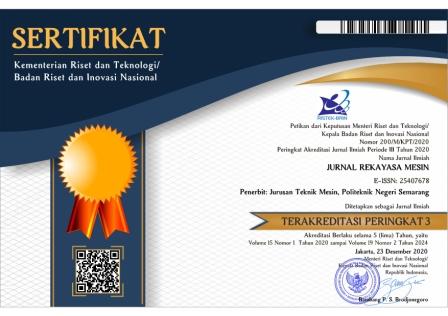Analysis of Biomass Briquettes Made from Bagasse Using Tapioca Starch Adhesive with Drying Temperature Variations
DOI:
https://doi.org/10.32497/jrm.v19i1.4974Keywords:
biomass briquettes, tapioca adhesive, bagasse, drying temperature, Indonesian National Standard (SNI)Abstract
Dependency on fossil fuels is making their availability increasingly scarce. Renewable energy is considered the best solution to replace fossil fuels, and at present, the primary focus should be on optimizing the utilization of renewable energy sources. As an example, biomass briquettes are being manufactured using bagasse and tapioca flour as adhesive in a 2:3 ratio. This study utilized a compression force of 50 kgf/cm2 and variations in drying temperatures (100 °C, 150 °C, and 200 °C) for 1 hour. The main objective of this research is to compare the quality of bagasse briquettes with the Indonesian National Standard (SNI) No. 01/6235/2000. The test results indicate that the best conditions were achieved at a drying temperature of 200 °C, with a moisture content of 4.47%, a calorific value of 5077.32 cal/g, a combustion rate of 0.1386 g/min, and carbon, volatile matter, and ash content percentages of 22.8333%, 26.845%, and 2.8323%, respectively.
References
Ang TZ, Salem M, Kamarol M, et al. A comprehensive study of renewable energy sources: Classifications, challenges and suggestions. Energy Strategy Reviews; 43. Epub ahead of print 1 September 2022. DOI: 10.1016/j.esr.2022.100939.
Erdiwansyah E, Mahidin M, Husin H, et al. Investigation of availability, demand, targets, and development of renewable energy in 2017”“2050: a case study in Indonesia. Int J Coal Sci Technol. 2021; 8: 483”“499.
Alfian D, Farhani AC, Supriyadi D, et al. Citronella Oil As Bioadditives on SI Engine Performance Characteristics. Jurnal Rekayasa Mesin. 2023; 14: 811”“822.
Ajala EO, Ighalo JO, Ajala MA, et al. Sugarcane bagasse: a biomass sufficiently applied for improving global energy, environment and economic sustainability. Bioresources and Bioprocessing; 8. Epub ahead of print 1 December 2021. DOI: 10.1186/s40643-021-00440-z.
Gani A, Erdiwansyah, Munawar E, et al. Investigation of the potential biomass waste source for biocoke production in Indonesia: A review. Energy Reports. 2023; 10: 2417”“2438.
Chen R, Ai Y, Zhang T, et al. Numerical simulation of biomass pellet combustion process. International Journal of Heat and Technology. 2019; 37: 1107”“1116.
INEGBEDÄ°ON F. Estimation of the moisture content, volatile matter, ash content, fixed carbon and calorific values of saw dust briquettes. MANAS Journal of Engineering. 2022; 10: 17”“20.
Anggraeni S, Ridwan Putri S, Bayu Dani Nandiyanto A, et al. Effect of Particle Size And Tapioca Starch Content on Performance Of The Rice Husk And Red Bean Skin Briquettes. 2021.
Tambunan H, Nuryawan A, Iswanto AH, et al. Briquettes Made of Branches Wood of Three Mangrove Species Bonded by Starch Adhesive. Materials; 16. Epub ahead of print 1 August 2023. DOI: 10.3390/ma16155266.
Ramdani LMA, Ahzan S, Prasetya DSB. The Effect of the Type and Composition of the Adhesive on the Physical Properties and the Rate of Combustion Hyacinth Biobriquettes. Lensa: Jurnal Kependidikan Fisika 2020; 8: 85.
Rizki M, Mustaqilla S, Rinaldi W, et al. The Effect of Adhesive Types of Damar and Pine Resin for Biobricket Manufacturing from Sugarcane Bagasse. Journal of Applied Technology; 9: 35”“42.
Ju YM, Lee HW, Kim AR, et al. Characteristics of carbonized biomass produced in a manufacturing process of wood charcoal briquettes using an open hearth kiln. Journal of the Korean Wood Science and Technology. 2020; 48: 181”“195.
Alfian DGC, Tambunan MJ, Paundra F, et al. The Effect of Pressure Variations on the Characteristics of Coconut Shell Based Briquettes Using Tapioca Starch Adhesive. ROTASI. 2023; 25: 23”“32.
Alfian DGC. BRIKET dari Limbah Menjadi Bahan Bakar. 1st ed. Lampung Selatan: ITERA Press, https://isbn.perpusnas.go.id/Account/SearchBuku?searchTxt=978-623-5404-77-6&searchCat=ISBN (2023, accessed 21 March 2024).
Anizar H, Sribudiani E, Somadona S. Pengaruh Bahan Perekat Tapioka Dan Sagu Terhadap Kualitas Briket Arang Kulit Buah Nipah. Perennial. 2020; 16: 11”“17.
Maulinda L, Mardinata H, Jalaliddin. Optimasi Pembuatan Briket Berbasis Limbah Ampas Tebu Menggunakan Metode Rsm (Response Surface methodology). Aceh Utara, 2019.
Standar Nasional Indonesia (SNI). Briket Arang Kayu SNI 01-6235-2000. Indonesia: BSN, 2000.
Rofiq MA, Hardjono H. Pengaruh Rasio Perekat Tepung Tapioka Terhadap Karakteristik Fisik Dan Pembakaran Briket Sabut Kelapa Dan Serbuk Gergaji Kayu Campuran. DISTILAT: Jurnal Teknologi Separasi. 2023; 9: 401”“411.
Ristianingsih Y, Mardina P, Poetra A, et al. Pembuatan Briket Bioarang Berbahan Baku Sampah Organik Daun Ketapang Sebagai Energi Alternatif. Info Teknik; 14.
Alabi O, Adeyi T, Ekun S. Analyzing Energy Performance and Assessing Dry Moisture Content of Briquettes through Numerical Investigations. Engineering and Technology Journal. 2023; 0: 1”“10.
Ahmad S, Winarso K, Yusron R, et al. Optimization of Calorific Value in Briquette made of Coconut Shell and Cassava Peel by varying of Mass Fraction and Drying Temperature. E3S Web of Conferences 2024; 499: 01009.
Ikelle II, Sunday NJ, Sunday NF, et al. Thermal Analyses of Briquette Fuels Produced from Coal Dust and Groundnut Husk. Acta Chemica Malaysia. 2020; 4: 24”“27.
Qin HW, Yang TM, Yang SB, et al. Effects of Different Pre-drying and Drying Methods on Volatile Compounds in the Pericarp and Kernel of Amomum tsao-ko. Front Plant Sci; 13. Epub ahead of print 25 February 2022. DOI: 10.3389/fpls.2022.803776.
Downloads
Published
How to Cite
Issue
Section
License
Copyright of articles that appear in Jurnal Rekayasa Mesin belongs exclusively to Penerbit Jurusan Teknik Mesin Politeknik Negeri Semarang. This copyright covers the rights to reproduce the article, including reprints, electronic reproductions, or any other reproductions of similar nature.







